Dahlia Planting Guide for Beginners
Do you love how dahlia flowers look but aren’t quite sure what it takes to grow these beautiful blooms in your garden? Today I’m sharing my dahlia planting guide for beginners with tips for planting, storing, growing, and how to care for dahlias.
Any beginning gardener can learn how to plant and care for dahlias. You’ll be surprised at how easy it is to grow these spectacular blooms with a bit of patience and knowledge. Trust me, your garden will never be the same again!
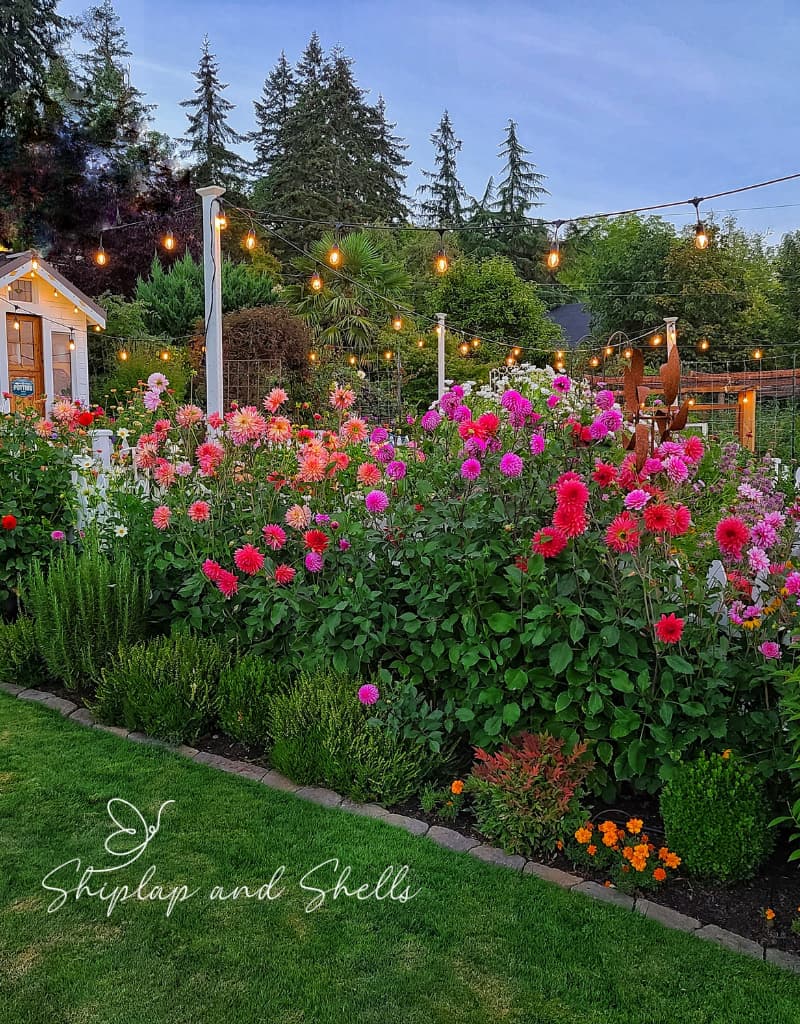
As an Amazon affiliate, I earn a commission from qualifying purchases at no additional cost to you. My blog also features other affiliate links for your convenience. Click here to read my privacy policy.
Abundant Dahlia Varieties to Choose From
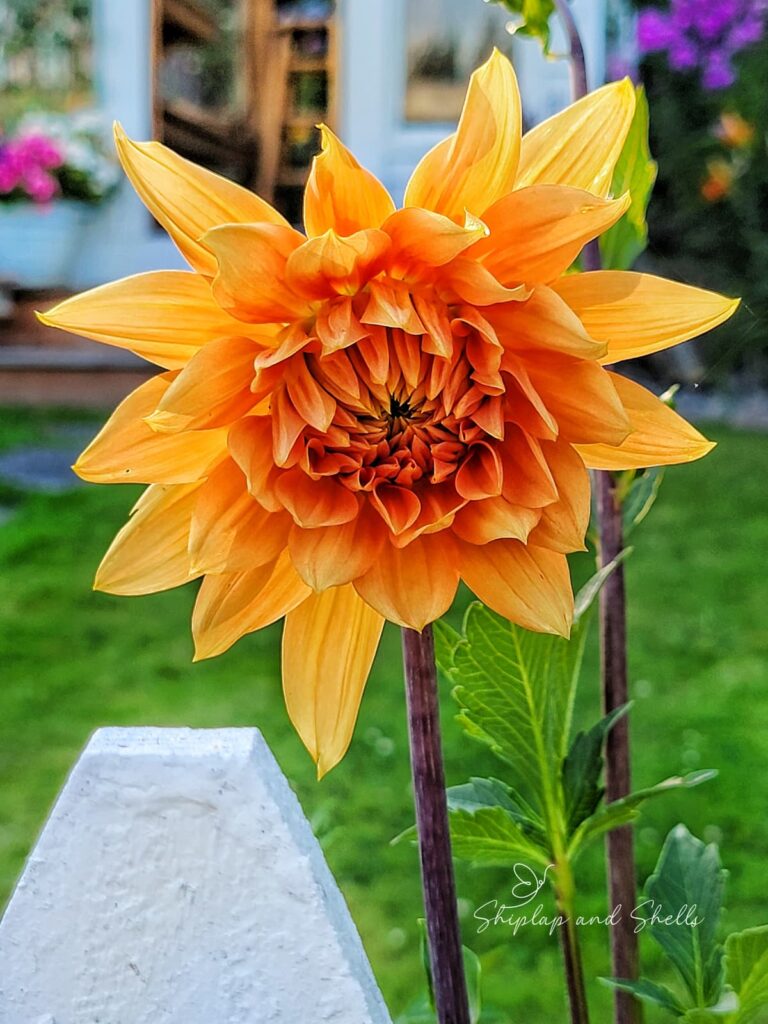
There are so many reasons why dahlias are my favorite flowers to grow in my cutting garden. According to The American Dahlia Society, there are 42 recognized dahlia species and several sub-species.
With so many stunning varieties of dahlias, there’s bound to be a size, color, and shape for everyone!
Dahlias take their time to reach full bloom in the summer season, but they are worth the wait! They peak at a time when many flowers in the garden are starting to die off.
Understanding Dahlia Growing Zones
Growing Dahlias in Hardiness Zones 8-11
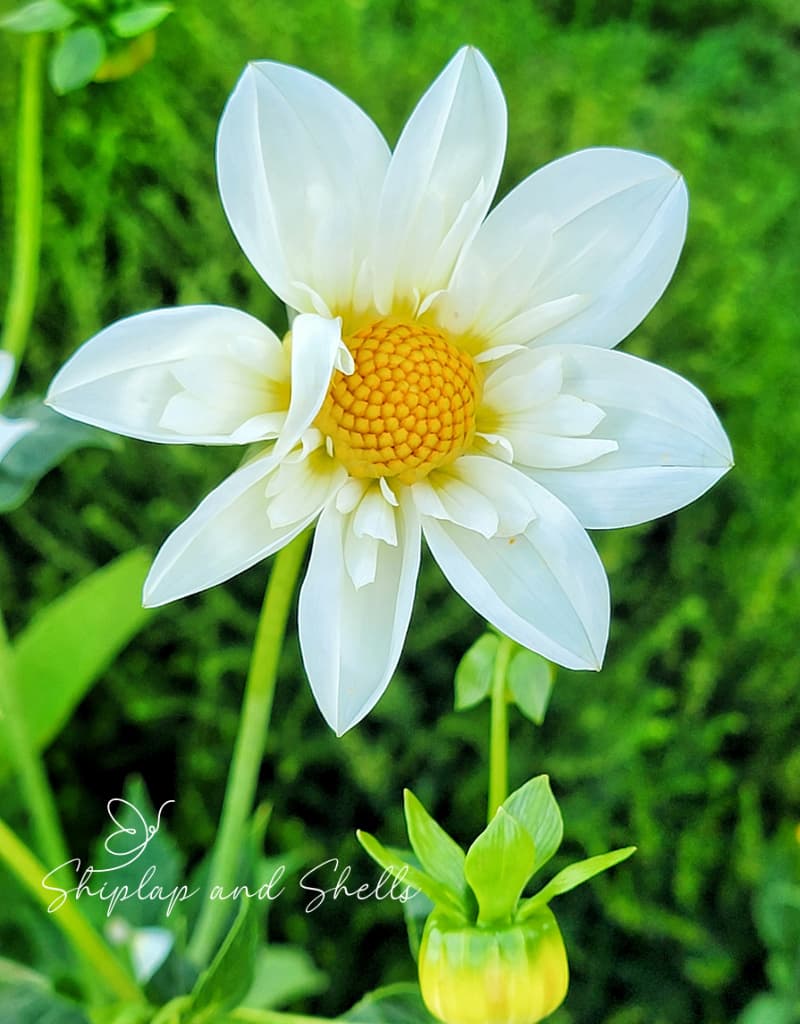
Dahlias are considered a tender perennial in cold regions of North America. They are only winter hardy in planting zones 8 to 11.
You’ll find dahlias in my garden, hardiness zone 8b, from mid-summer through the fall’s first frost. They’re usually the last flowers blooming in my fall garden.
It’s recommended that your dahlia tubers be dug up and overwintered in a cool, dry area before the first hard freeze of the season. I’ll touch on that process later on in this post.
I keep my tubers in the ground year-round. However, I take extra care to make sure my tubers have added protection during the winter months by putting a thick layer of mulch or mowed up leaves around each plant.
Growing Dahlias in Planting Zones 2-7
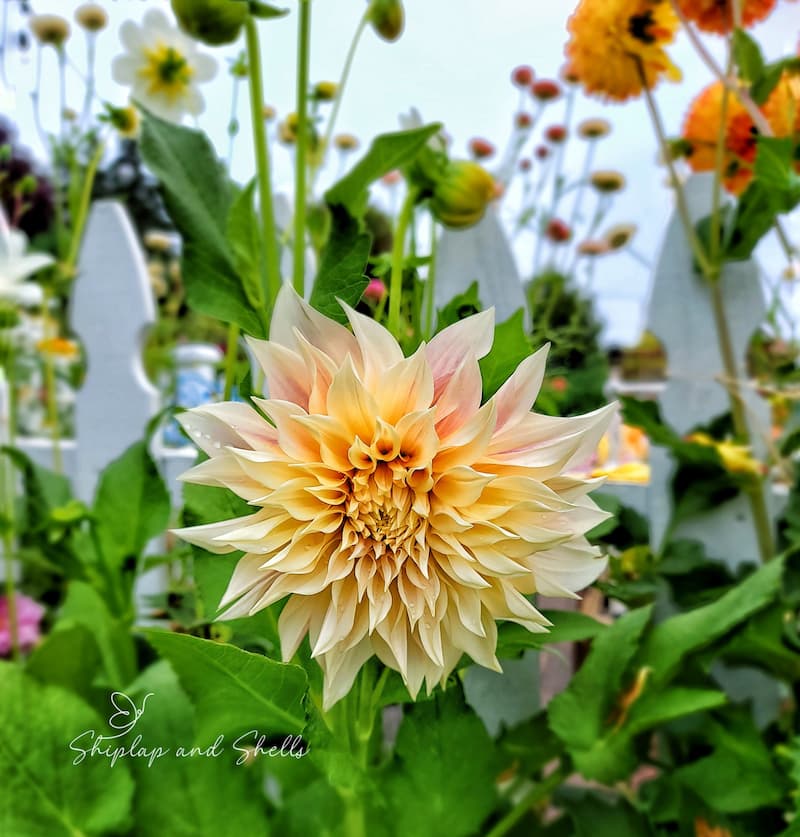
Gardeners in zones 2 to 7 should be planting dahlia tubers in the spring, and either treat them as annuals or dig them up and store them through the winter.
Dahlias should begin to bloom in mid to late summer and continue until the first frost.
Seed Starting Supplies
Check out my favorite supplies and tools for starting seeds indoors. Whether you’re looking for grow lights or a seed starting mix, you’ll find what I use in my own greenhouse.
Ideal Dahlia Growing Conditions
Soil Requirements for Growing Dahlias
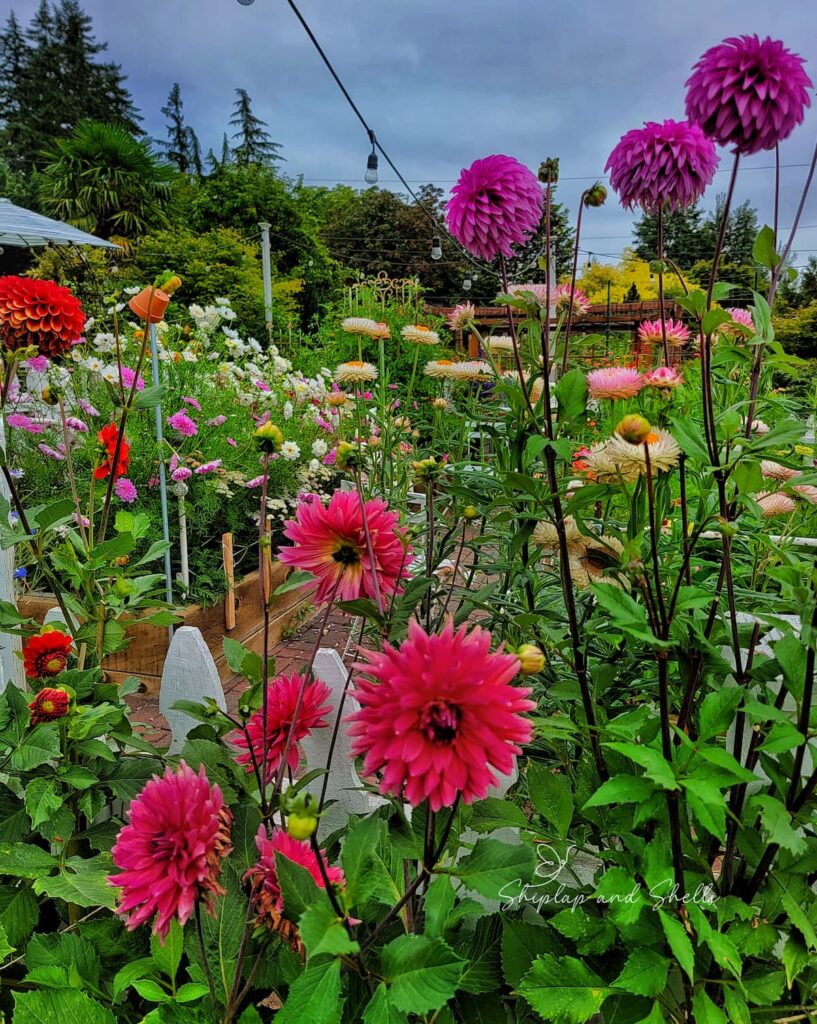
When planting dahlias outdoors, pick a spot in the garden with well-draining soil, and amend your beds with 2-4 inches of high-quality compost or well-rotted manure, a light dusting of bone meal, and a balanced organic fertilizer.
Mix all ingredients into the soil to distribute evenly.
Sunlight Requirements
Dahlias require 6-8 hours of full sun a day and are sensitive to frost.
While dahlias need a good amount of sunlight to grow and bloom, they can get too much sun, especially in hot and dry climates.
When they get exposed to excessive heat and direct sunlight for extended periods, the dahlia foliage and blooms can become wilted or scorched.
For best results, provide shade as protection for your dahlias during the hottest parts of the day, especially in areas with intense sunlight. Shade cloth works well, or you can plant your dahlias in a spot that receives partial shade during the hottest hours of the day.
Temperatures above 90°F can be too hot for dahlias if they are exposed to direct sunlight for extended periods.
READ MORE ABOUT HOW TO PROTECT YOUR GARDEN FROM EXCESSIVE HEAT HERE.
Best Practices for Planting Dahlias Outdoors
What are Dahlia Tubers?
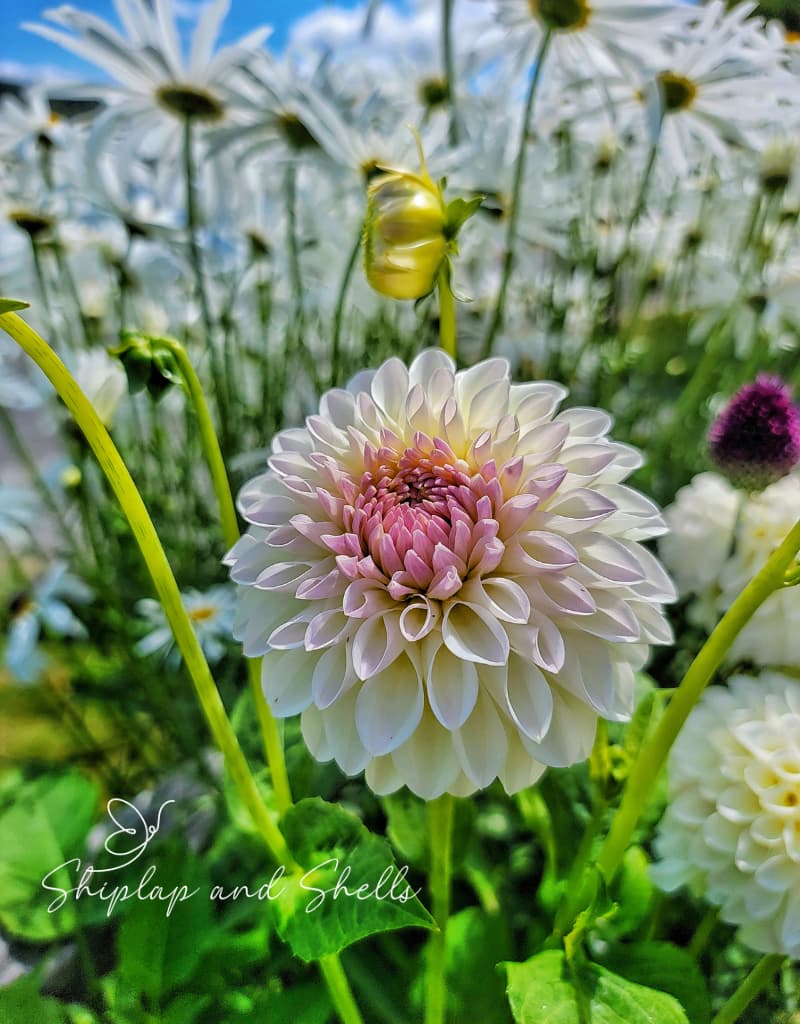
Dahlia tubers are the underground storage structures of the plant. They typically range in size from a few inches to several inches in diameter, depending on the variety.
The tuber is where the plant stores the nutrients and energy that the plant will use to grow and produce blooms in the upcoming season.
Supplies for Planting Dahlias Outdoors
Planting and growing dahlias require some specific supplies and tools to ensure you grow healthy tubers and produce beautiful blooms.
Here’s a list of some of the items you’ll need on hand.
When to Plant Dahlia Tubers
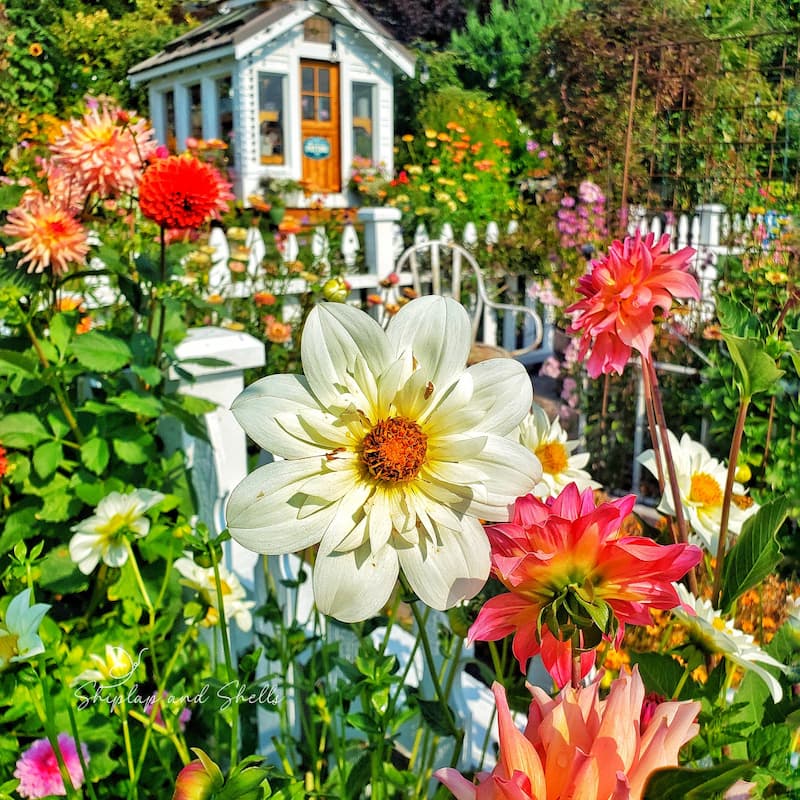
The planting time for tubers should be in the spring once the ground temperature reaches 60°F and the danger of frost is gone.
For most regions in the United States, the best time to plant dahlias is between mid-April and mid-May. This allows the plants to establish themselves before the summer heat sets in and will provide enough time for them to grow and produce blooms before the first frost in the fall.
Planting dahlias too early in the season can result in the tubers rotting in the cold and damp soil. If you plant them too late it can result in shorter bloom times or the plants not blooming at all.
You can try to get a head start on the growing season by starting tubers indoors in individual containers a month earlier than they would be planted in the ground.
Where to Plant Dahlia Tubers
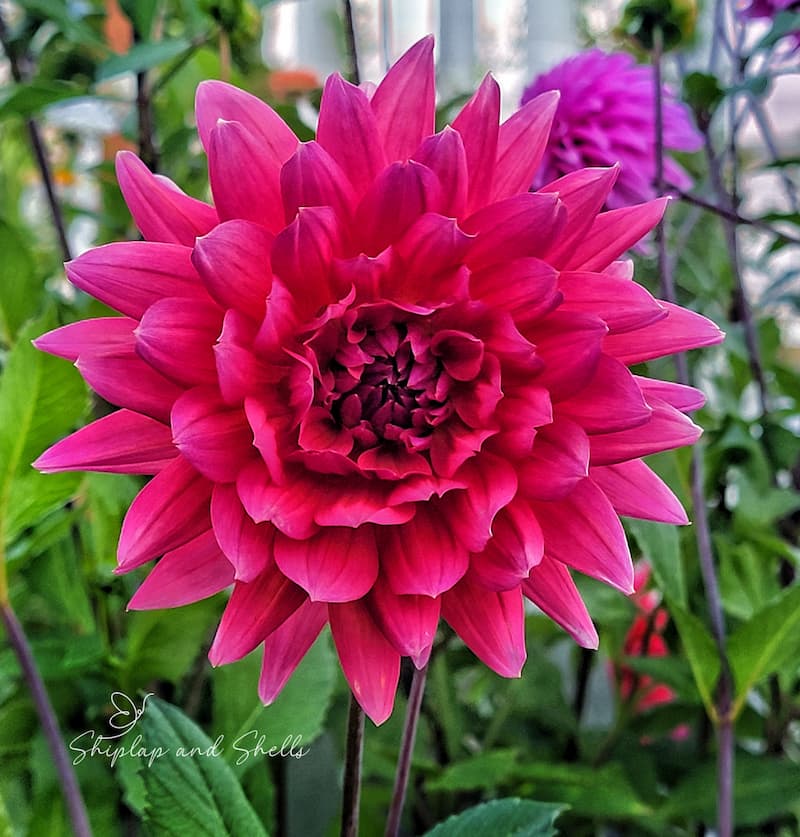
As we’ve already covered, dahlias require 6-8 hours of full sun a day to thrive and need well-draining soil.
Provide Proper Space
When planting dahlias, it’s important to leave enough space between each plant for healthy growth and to avoid overcrowding.
The amount of space needed will depend on the variety of dahlia plants you’re planting. As a good rule of thumb, you should plant dahlias at least 12-18 inches apart from one another. This will allow enough space for each plant to develop a strong root system and grow to its full size without competing for resources with other plants.
It’s also important to consider the spacing between your dahlia plants and any surrounding plants. You should leave at least 18-24 inches between the dahlias and other plants for good air circulation and prevent the spread of disease.
How to Plant Dahlia Tubers
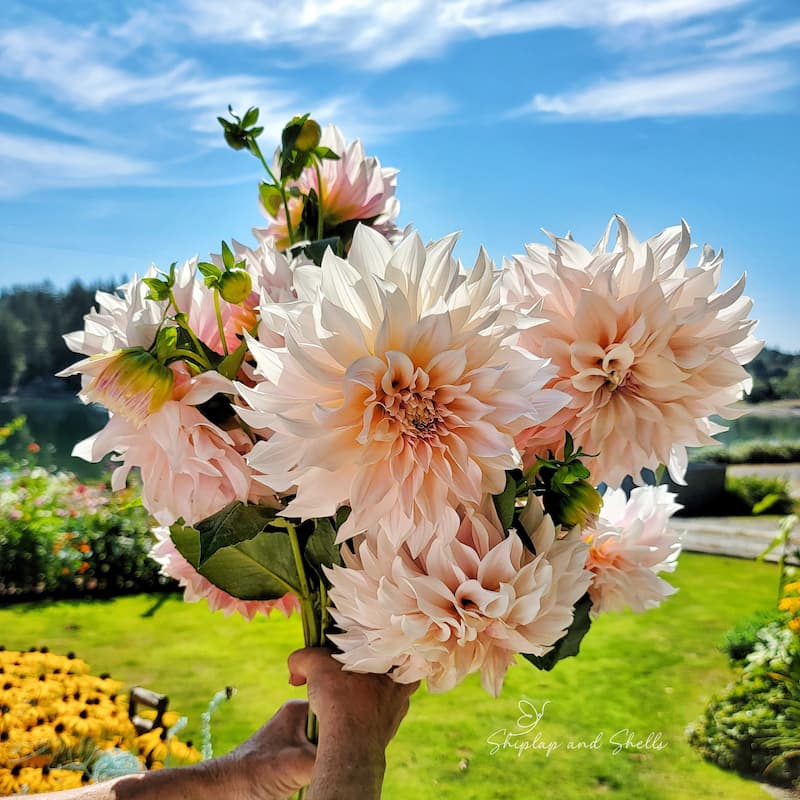
For dahlia tuber planting after the last frost date, dig a hole 4-6 inches deep and lay the tuber on its side, horizontally, with the growing eye facing up. Cover with a few inches of soil. Space the tubers in the ground between 12-18 inches.
You can also add a layer of mulch around your dahlias to help regulate soil temperature and moisture which is beneficial to plants.
As the plant grows, it will produce stems, leaves, and eventually blooms.
You do not need to water your dahlia plants until you see the first set of true leaves. Watering too soon can lead to the tubers rotting.
Can you Plant Dahlia Tubers Too Deep?
Yes. If you plant the tuberous roots too deep it can lead to poor growth with weak stems and leaves or even the death of the plant. The dahlia plants need access to light and air to thrive.
Dahlia Care and Maintenance Tips
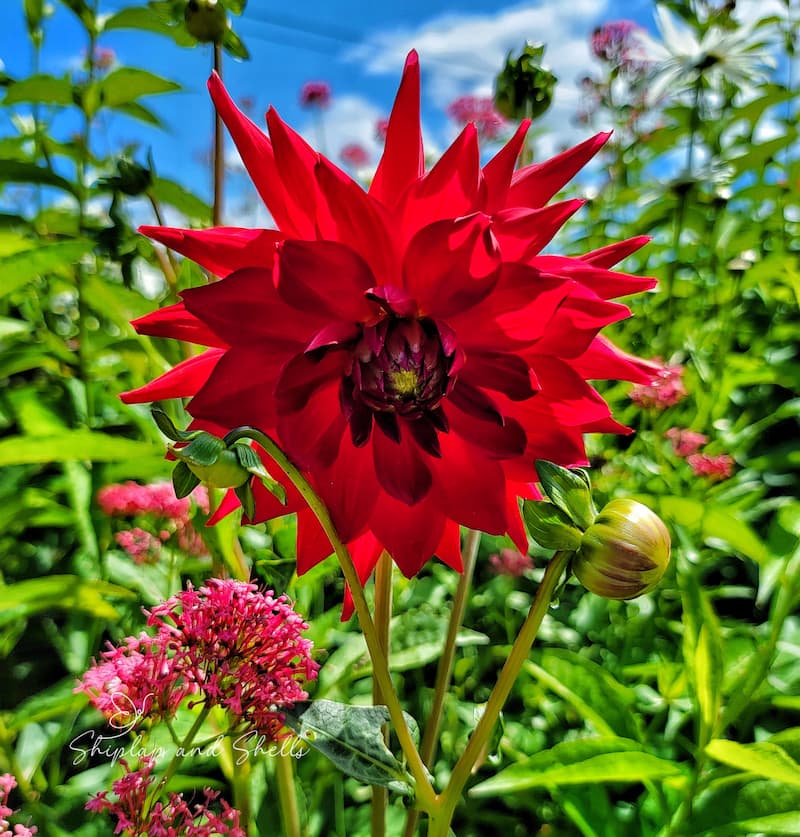
In this section I’ll cover how to care for your dahlias, including watering needs, pinching back young plants, supporting large dahlias, and pest control tips.
Watering Your Dahlias
Wait to water newly planted tubers until after you see the first green shoots coming up through the ground. Watering before any new growth is visible can cause the tubers to rot.
After your dahlias are established, you should water your plants deeply 2-3 times a week for at least 30 minutes. I have a drip system that works well. You will need to give your dahlia plants more water in hot and dry climates.
Overwatering can lead to root rot, yellowing leaves, stunted growth, mushy stems, and fungal diseases.
Fertilizing Dahlia Plants
When fertilizing dahlias, use a balanced fertilizer that provides the necessary nutrients for the plant. You can apply fertilizer in the form of a granular or a water-soluble. Follow the manufacturer’s instructions for application rates and timing.
If possible, apply fertilizer every 4-6 weeks during the growing season when the plants are about 6 inches tall.
Be sure to water your plants well before and after applying fertilizer to avoid burning the roots and to help the fertilizer absorb into the soil.
Over-fertilization can be harmful and lead to excessive vegetative growth, taking away from the blooms.
When to Pinch Dahlias and the Benefits
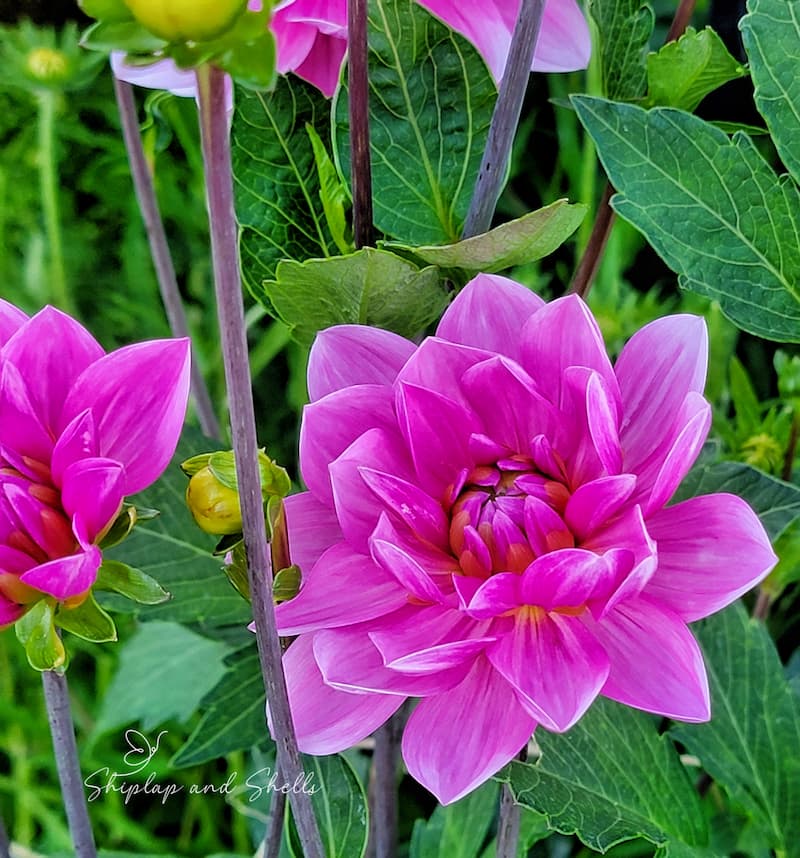
An important step in caring for dahlias is pinching the center shoot when the plant is young.
After dahlia plants reach about 1 foot tall, pinch them by snipping out 3-4 inches of the growing center branch.
This process will cause the plant to redirect its energy into producing more side shoots, encouraging bushier plants, as well as increasing flower production and overall stem length.
What Happens if You Don’t Pinch Dahlias?
If you don’t pinch your dahlias they will still grow and produce blooms. However, they may be less full than if you had pinched them. This is because the plant will grow taller and more spindly, rather than branching out and producing new shoots.
LEARN MORE ABOUT PINCHING BACK PERENNIALS HERE.
Pest and Disease Control
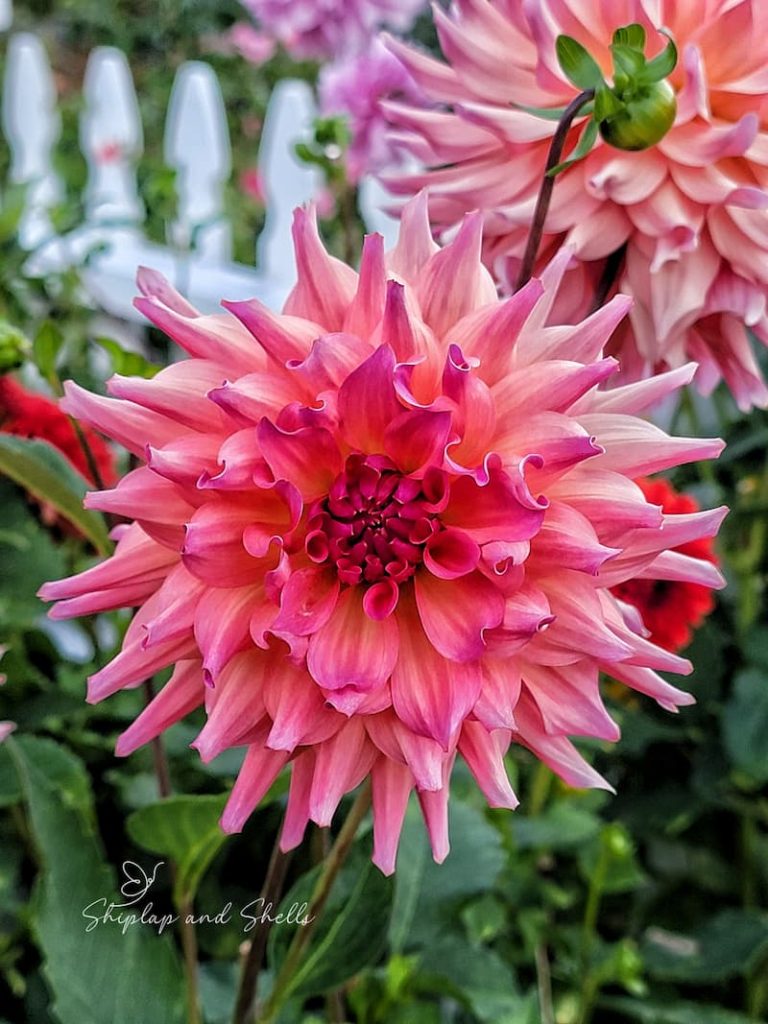
Slugs and snails love eating young dahlia plants, and earwigs ruin the flowers. Be sure to put down slug bait, not only after planting the tubers but throughout the season.
There have been times when I’ve forgotten to put slug bait down around my new dahlia plants and the slugs enjoyed eating the entire plant. I use Sluggo, which is an organic option that’s safe for both children and pets.
Every fall I seem to find powdery mildew on my dahlia leaves. You can proactively spray for this from late July to August to prevent this from happening to your leaves.
LEARN MORE ABOUT HOW TO USE NATURAL PEST CONTROL METHODS HERE.
Staking Your Dahlia Plants
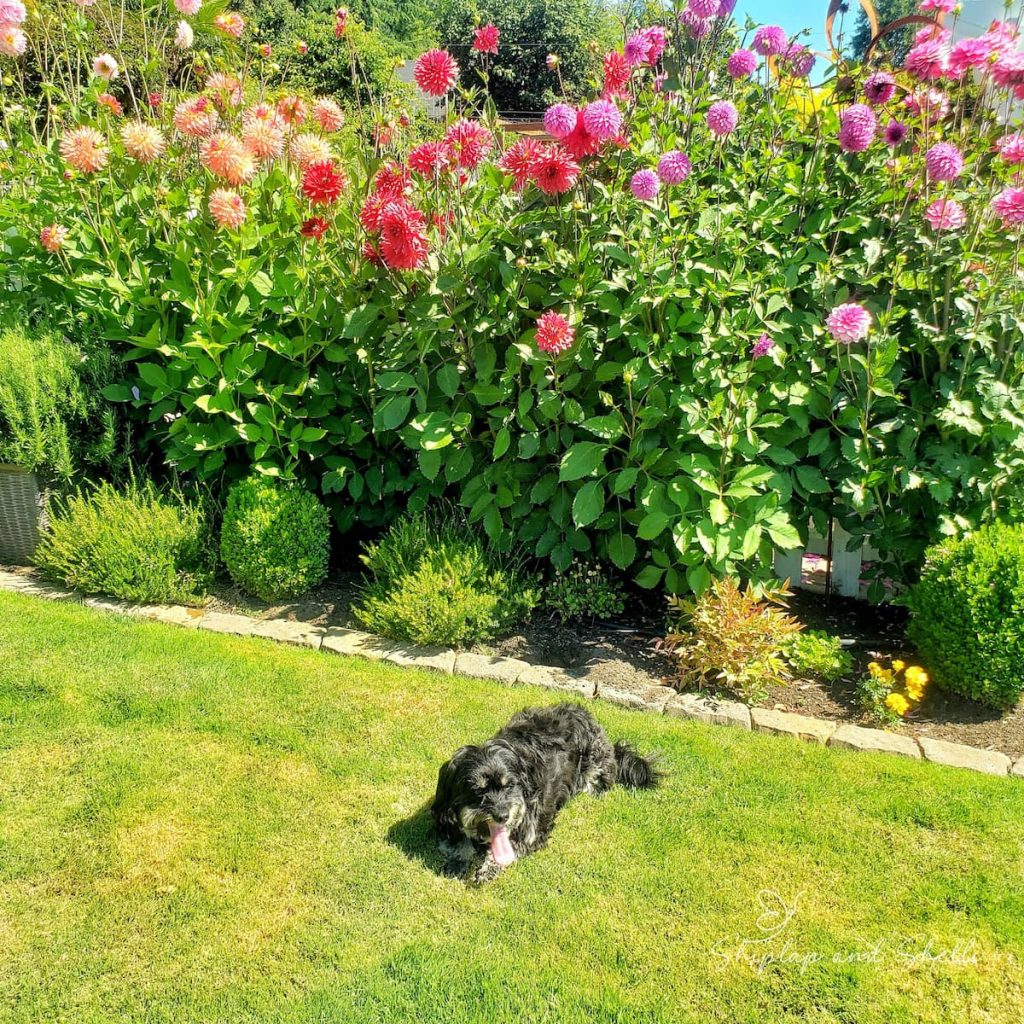
You will need to stake your dahlia plants when they are a couple of feet tall to keep them from falling over and snapping the stems.
Heavy rains, wind, and the weight of dinnerplate-sized dahlias are all causes for dahlia plants breaking off and falling over.
In areas where I have several dahlias planted in a row, I use the corral method. This method involves placing a metal T-post every 8 feet along the outside edges of the beds and stringing a double layer of bailing twine from post to post.
Deadheading Dahlia Plants
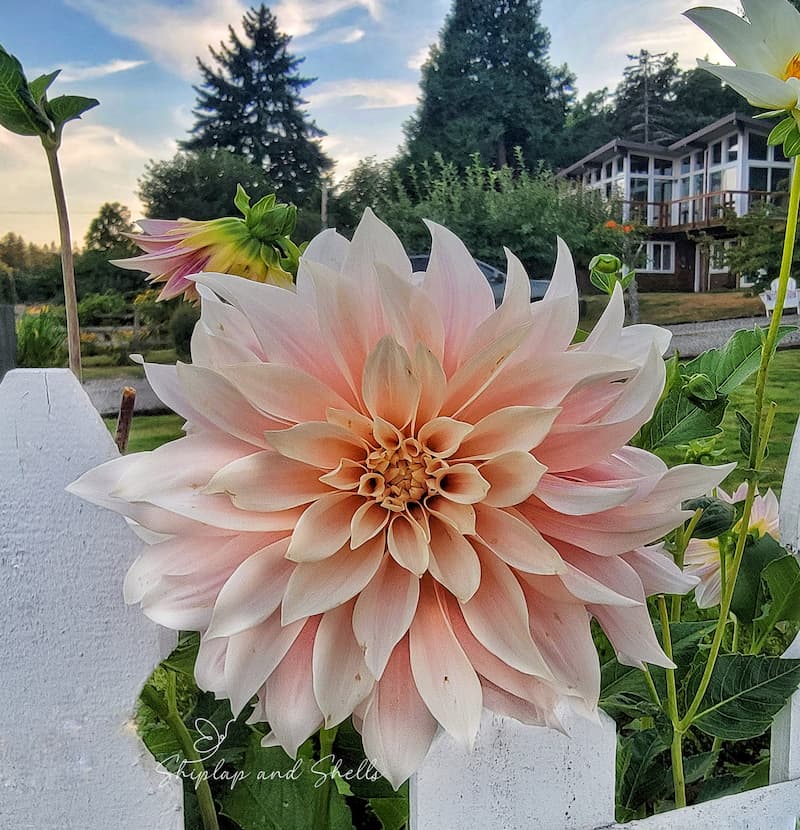
Deadheading is removing the spent flower heads.
To get continual flowering throughout the season, deadheading should be done consistently. It prompts the plant to produce more flowers.
Cut back just above the point where the flower stem joins a central stem.
Harvesting Dahlia Plants
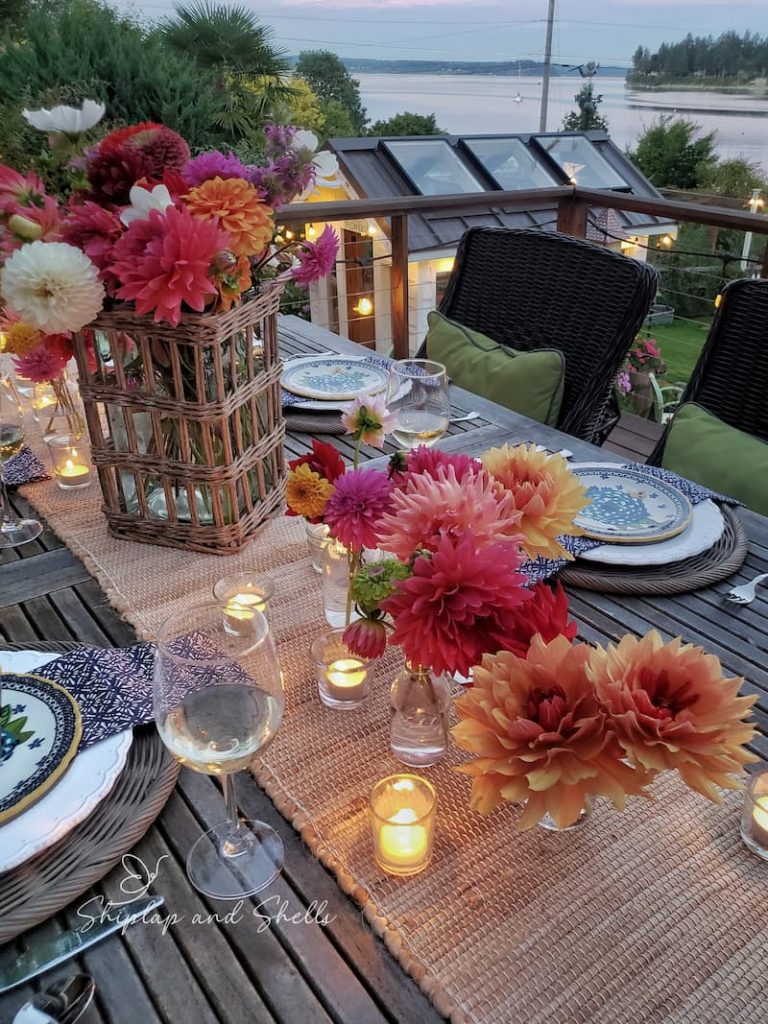
One of my favorite things about dahlias is that the more flowers you cut, the more blooms your plant will produce.
When to Cut Dahlia Plants
The best time to cut dahlias is in the early morning before the heat of the day to keep them from shock and wilting.
Since dahlias don’t open much after being harvested, it’s important to pick them almost fully open but not overly ripe.
YOU CAN SEE MORE OF THIS SUMMER EVENING TABLESCAPE HERE.
How to Cut Dahlia Plants
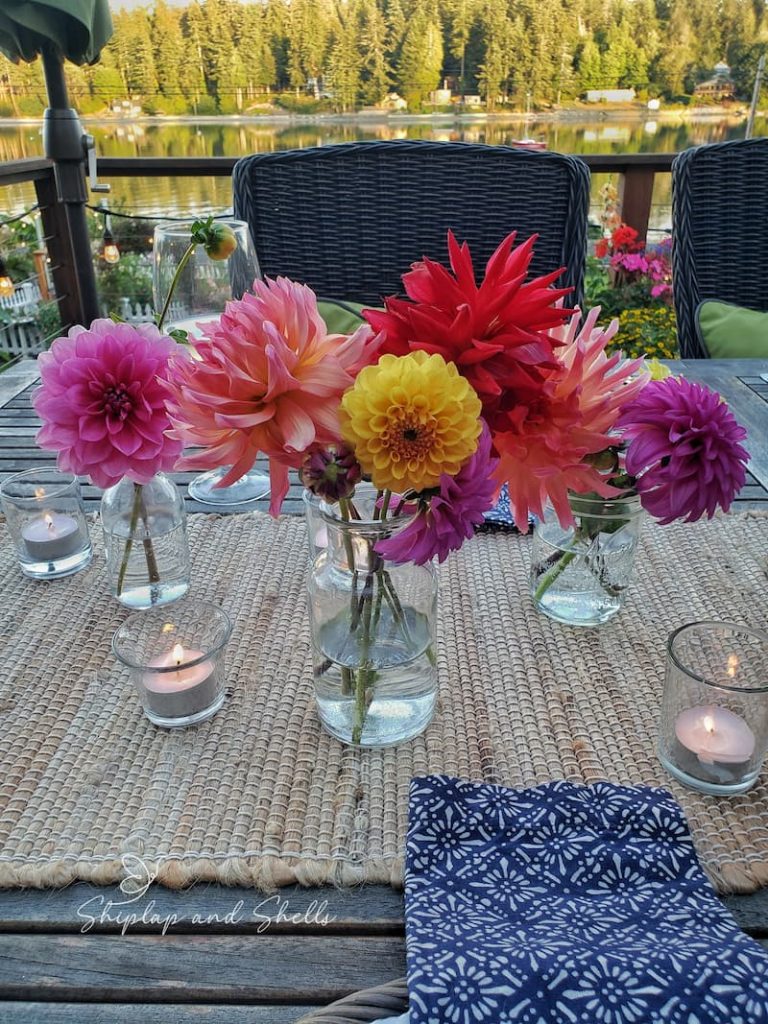
When cutting dahlias, use sharp, clean pruners or shears to make a clean cut at a 45° angle, just above the set of leaves or nodes.
This will encourage the plant to produce more blooms and prevent damage to the plant.
Place the cut flowers in a bucket of cool water as you are cutting from the garden. Remove all leaves from the stems and place the dahlias in a vase of water with flower food.
Don’t use a flower for your arrangement if the back of the flower head looks like the petals are browning and dehydrated.
The cut flowers should last anywhere from 5-7 days if properly cared for.
Dahlia Winter Care and Storage
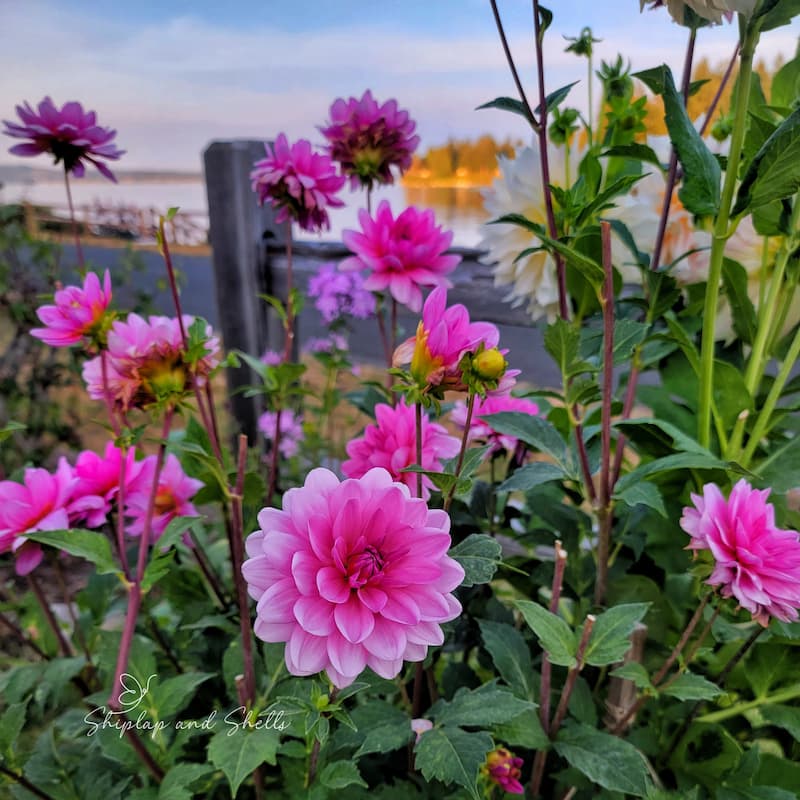
Dahlia plants will blacken after the first hard frost. Once this happens, cut all but 1-4 inches off the plant.
Should You Leave Your Dahlia Tuber in the Ground or Dig Them Up and Store Them for the Winter?
If you live in hardiness zones colder than 8, carefully dig up the tubers with a pitchfork or shovel, being careful not to damage them, and store them through the winter.
If you live in an area where the dahlias can be cut back and left in the ground to overwinter, protect them by spreading a thick layer of mulch or mowed up leaves around the plant to add protection.
LEARN MORE ON HOW TO DIG UP AND STORE DAHLIA TUBERS HERE.
Dividing Dahlia Tubers to Overwinter
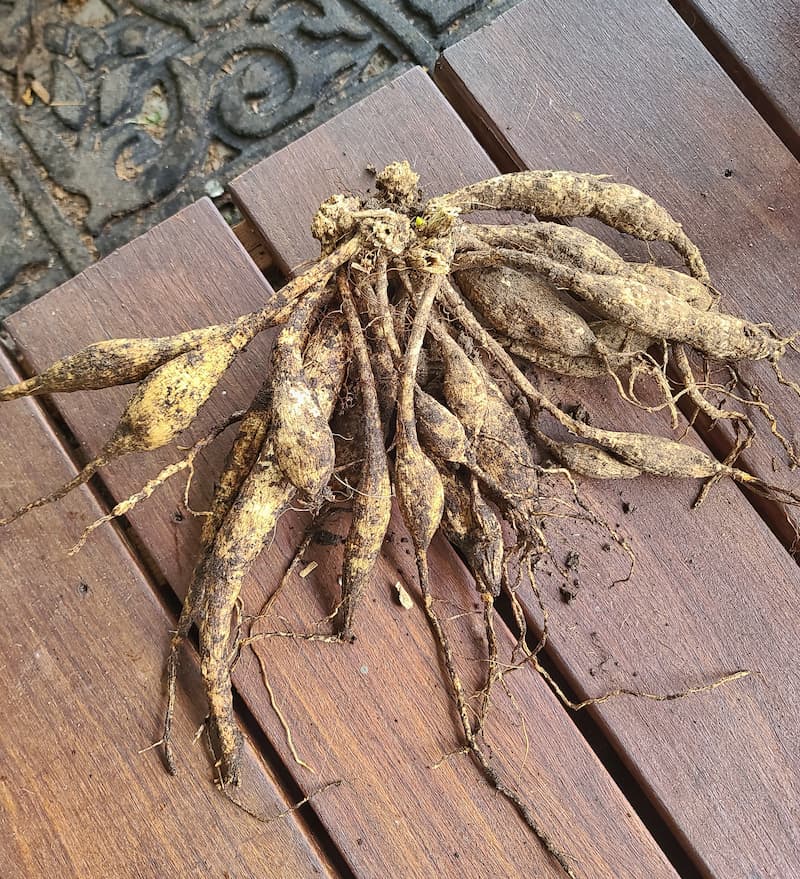
Whether you choose to divide dahlia tubers before storing them for the winter or in the early spring, be sure to split them every year because of how quickly they grow. If they get too large, they will rot or become too heavy to lift and store.
After digging up your tubers, split the tubers in half with sharp pruners or a sharp knife so the pieces are easier to work with. Remember that for a tuber to be viable, the eye or eyes must be connected to an unbroken tuber.
Wash the clumps to remove all the excess soil. Dip the clumps into a 5% bleach-95% water solution and lay them out to dry in a cool place, such as a basement or garage for a couple of days.
Storing Dahlia Tubers Until Spring
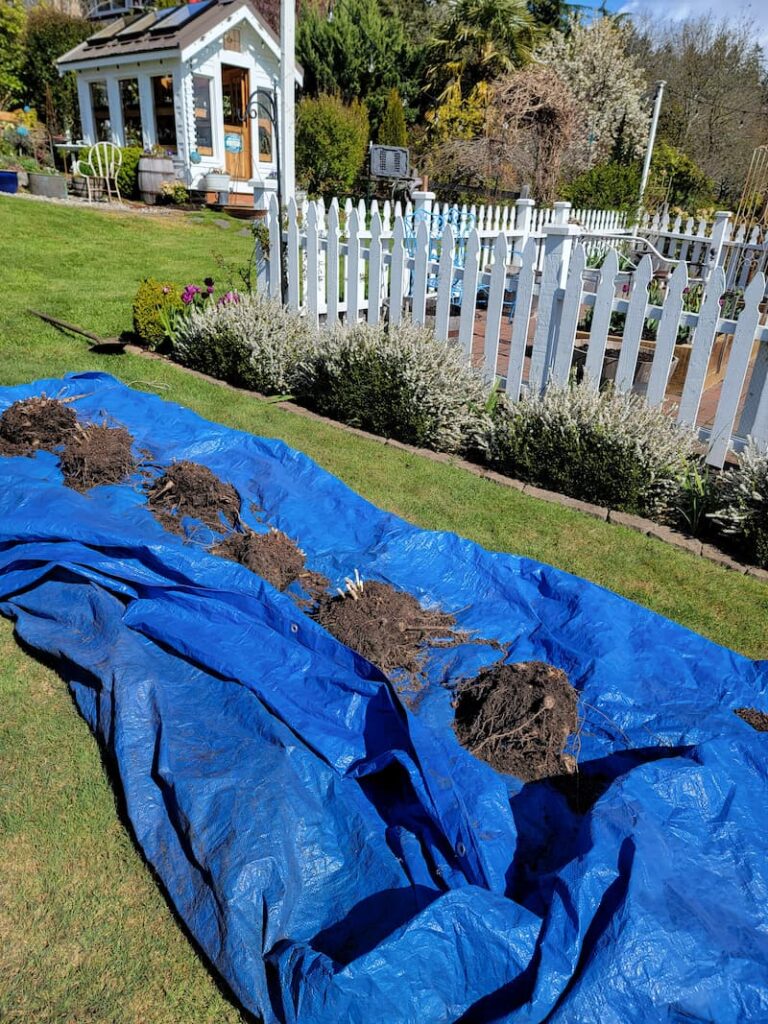
Once the dahlia tubers are dry, pack them in slightly dampened peat moss or sawdust, and then in cardboard boxes lined with newspaper or paper bags.
You can also individually wrap them in pieces of plastic cling wrap.
Store them in a well-ventilated, frost-free place, from 40-45º F. Try to keep the tubers from touching each other. That way, if one of them rots, the others will be protected.
Check tubers monthly throughout the winter, and dispose of any that have started to rot.
Spring Best Practices for Dahlias

If you have stored the dahlia tubers for the winter, then you have most likely divided the tubers before storing them away for the winter.
And for those who left the tubers in the ground, it’s now time to divide your dahlia tubers in spring.
No matter which way you choose to store your dahlias through the winter season, you’ll need to inspect your tubers for any that are rotted or diseased, as well as splitting the parent plant tuber from the rest of the clump.
Remember that each tuber must have at least one eye, or the tuber will not bloom. The eyes are located at the base of the stem and look like little pink bumps.
READ MORE ON HOW TO DIVIDE DAHLIA TUBERS HERE.
Dahlia Care Frequently Asked Questions
Do Dahlias Do Better in Pots or Ground?
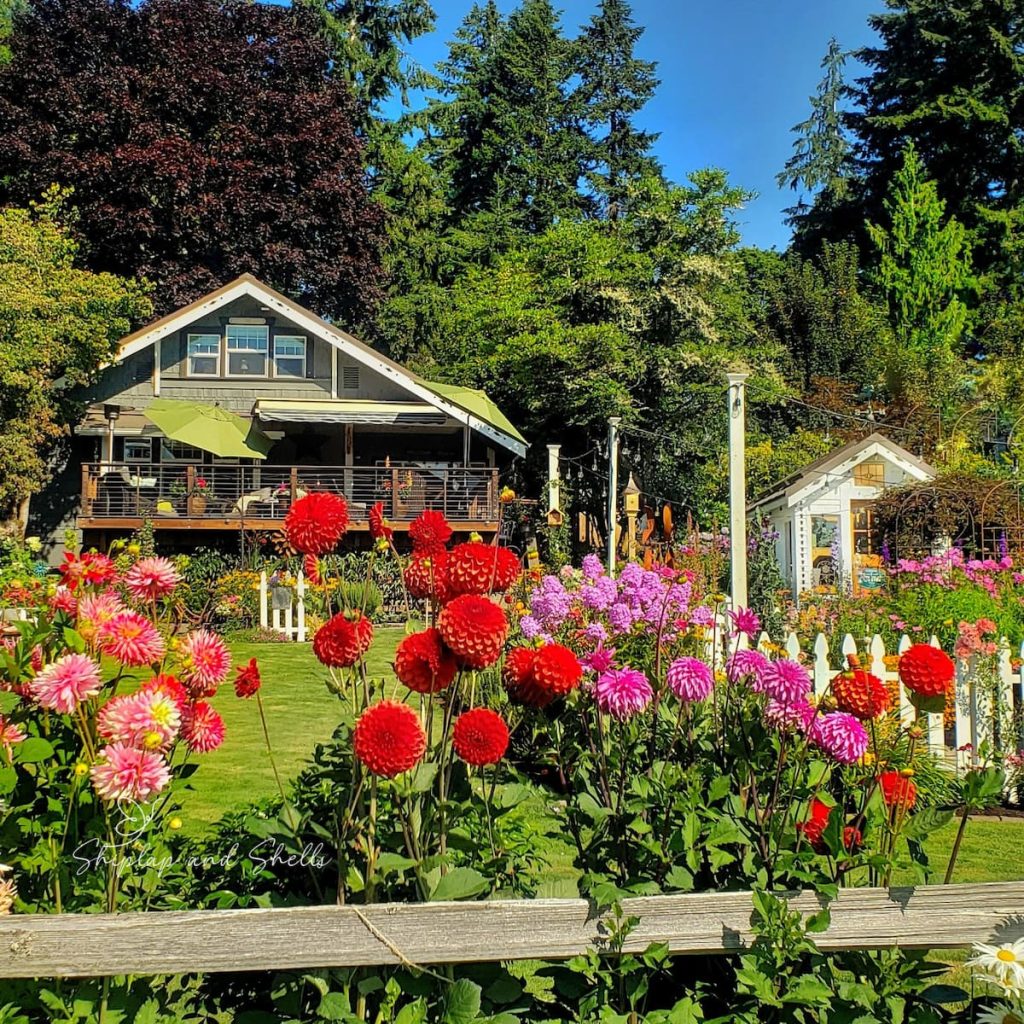
Dahlias can be grown successfully in both pots and the ground. Your growing method choice depends on personal preference, available space, and growing conditions.
Do Dahlias Come Back Every Year?
Dahlias are capable of coming back year after year in certain conditions and climates.
In warmer climates, such as USDA hardiness zones 8-11, dahlias can be left in the ground over the winter and may return the following year.
However, in colder climates with freezing temperatures, dahlia tubers can be damaged or even killed if not taken out of the ground and stored indoors for the winter.
Do Dahlia Flowers Spread?
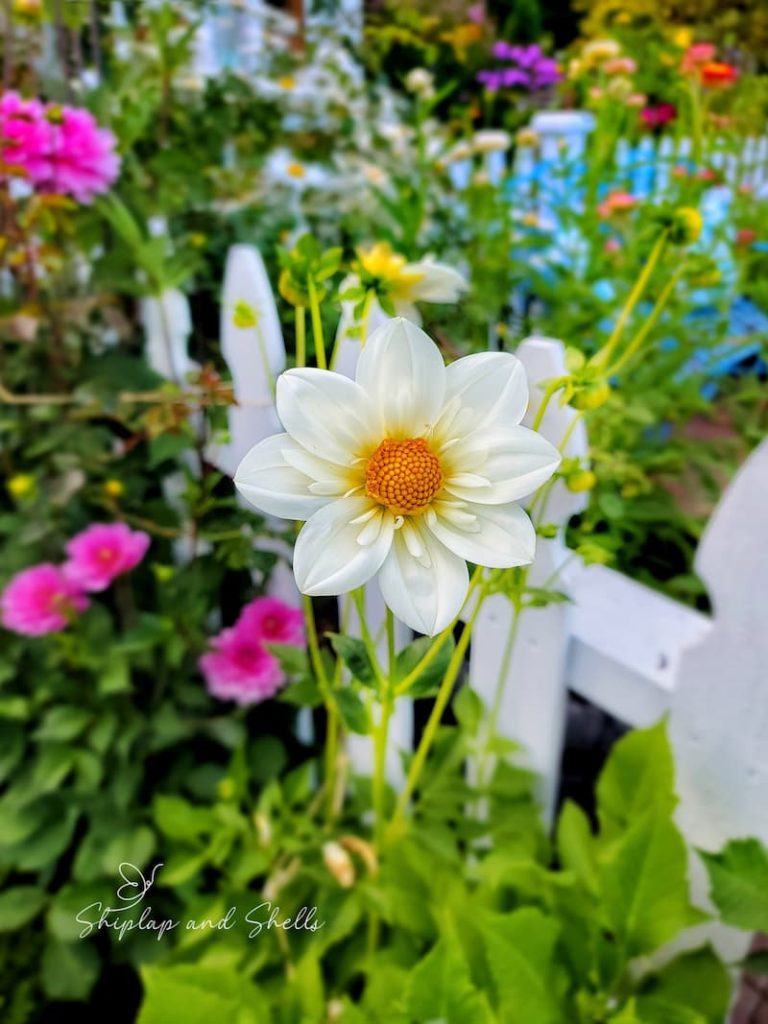
Dahlia flowers don’t typically spread or propagate on their own and are not self-seeding plants. New plants must be grown from the divided tubers of an existing plant.
What Happens if You Don’t Dig Up Dahlias?
If you live in an area where dahlias are not hardy and don’t dig them up in the fall, the tubers may be damaged or killed by freezing temperatures.
This can result in the loss of the entire plant because the tubers won’t be able to produce new growth the next spring.
Do You Soak Dahlias Before Planting?
It’s not necessary to soak dahlias before planting because they should absorb the moisture they need from the soil. However, soaking the tubers for a short period before planting can help hydrate them and encourage the growth of healthy roots.
Why are My Dahlias All Leaves and No Flowers?
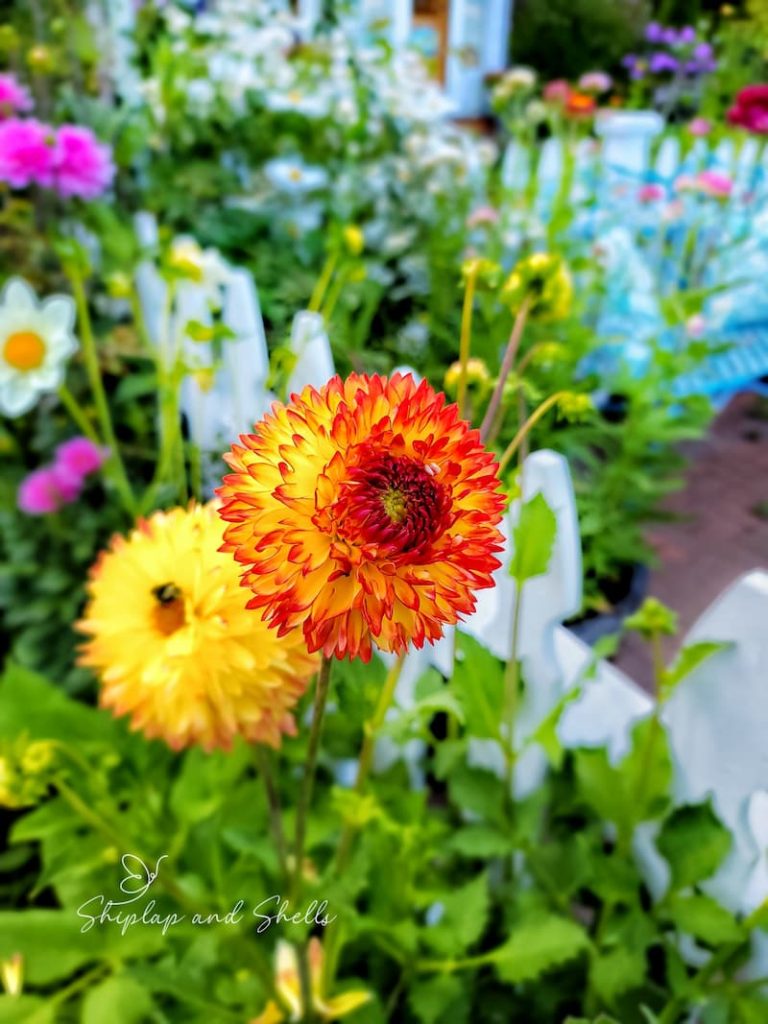
There could be many reasons why your dahlias are not flowering: lack of sunlight, overfertilization, improper planting depth, lack of water, or pest or disease issues.
Should I Remove Lower Leaves from Dahlias?
Removing lower leaves from dahlias can be beneficial for promoting airflow and preventing pest and disease issues. Avoid removing more than one-third of the plant’s foliage at once to make sure the plant can still produce the energy it needs to grow and bloom successfully.
Leaves are essential for photosynthesis and providing energy to the plant so don’t go overboard.
Does Picking Dahlias Encourage More Flowers?
Yes, cutting dahlias can encourage more flowers to bloom. When you remove the spent flowers, it stimulates the plant to produce new blooms. Removing flowers can also help to direct the plant’s energy towards producing new blooms rather than developing the seed heads.
Garden Supplies and Tools
Check out my favorite garden supplies and tools for the growing season. Whether you’re looking for potting soil or deer repellent, you’ll find what I use in my own garden.
Final Thoughts
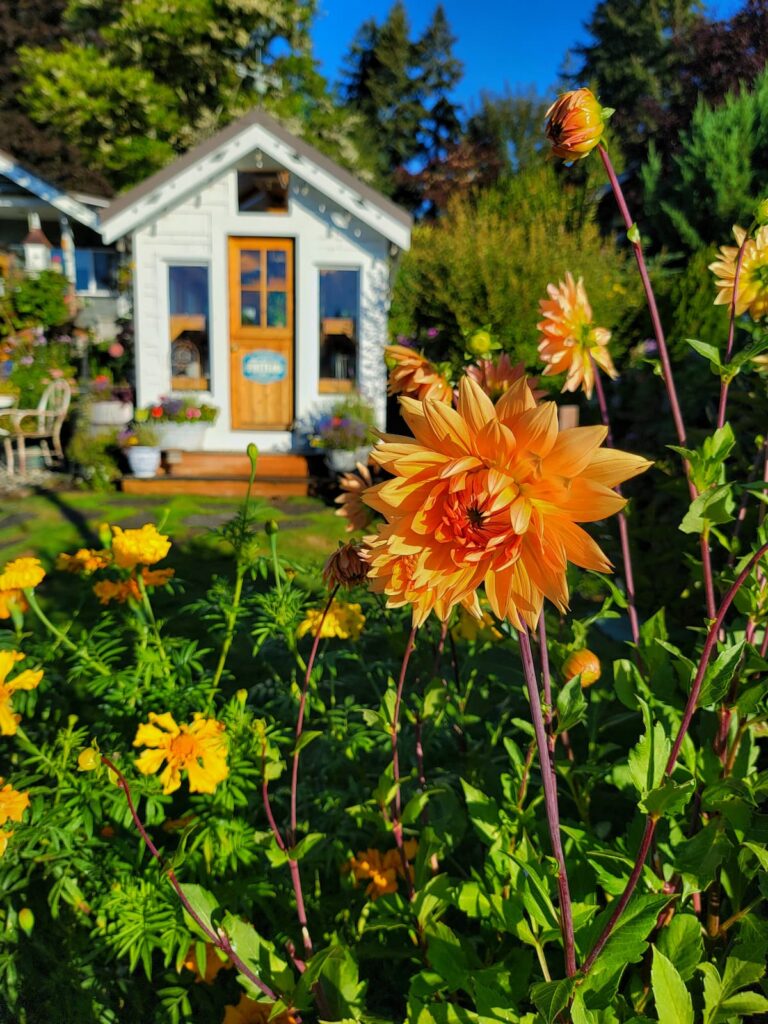
I hope my dahlia growing tips have been useful and inspired you to grow your own dahlias in the garden.
Dahlias are stunning cut flowers that take a bit of work such as dividing, storing, and staking, But you will not find a more beautiful flower that produces so many blooms and looks so gorgeous in the garden.
If you have any questions or additional suggestions, please share them in the comments below. And be sure to share this blog post link with anyone who may find these gardening tips useful.
Until next time,
Happy Gardening!

I’m a self-taught hobby gardener. Everything I share on my blog is my opinion and what has worked for me.
More Garden Posts to Enjoy
Follow Me for More Inspiration
Shop my Amazon Storefront, LTK sources, and my favorite home decor, garden, and lifestyle products. When you purchase from one of my links, I earn a small commission, which helps me continue sharing all the content you expect on my blog.
Be sure to follow me on Pinterest, Instagram, Facebook, TikTok and LIKEtoKNOW.it. Do you like gardening? Join my Facebook Gardening Tips & Tricks group.

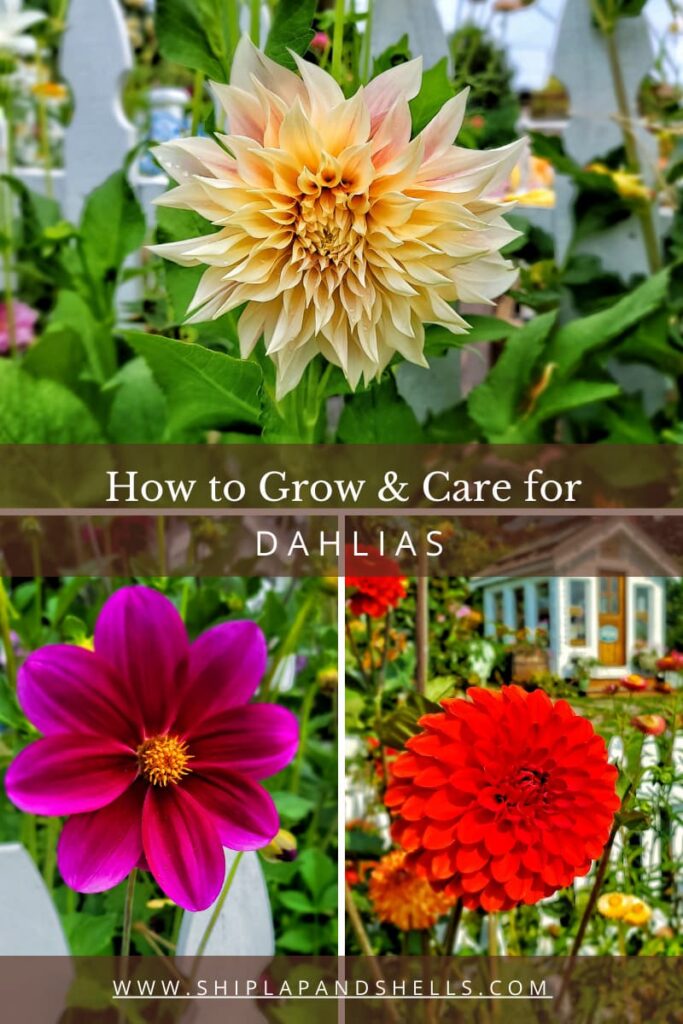
|


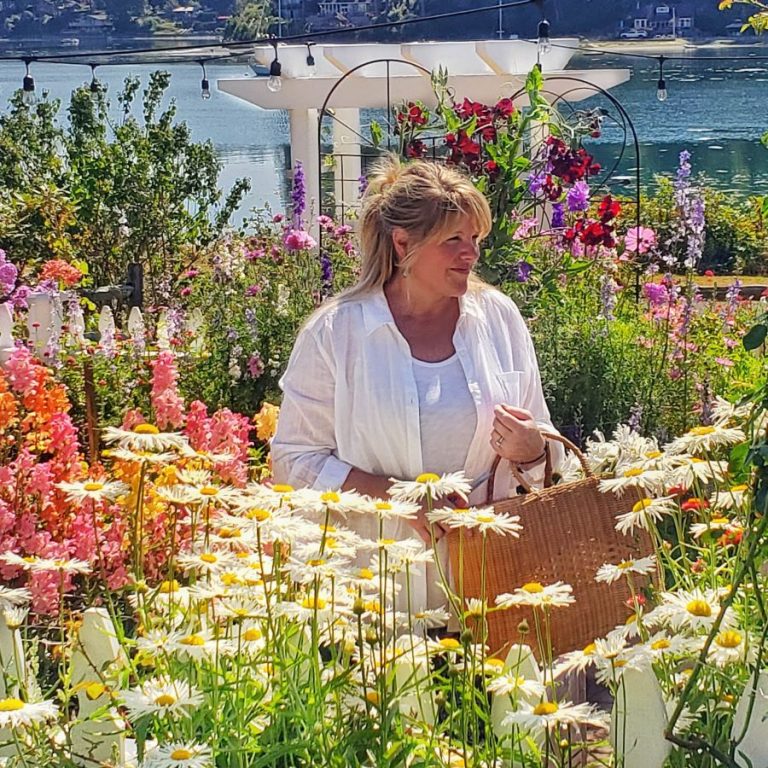
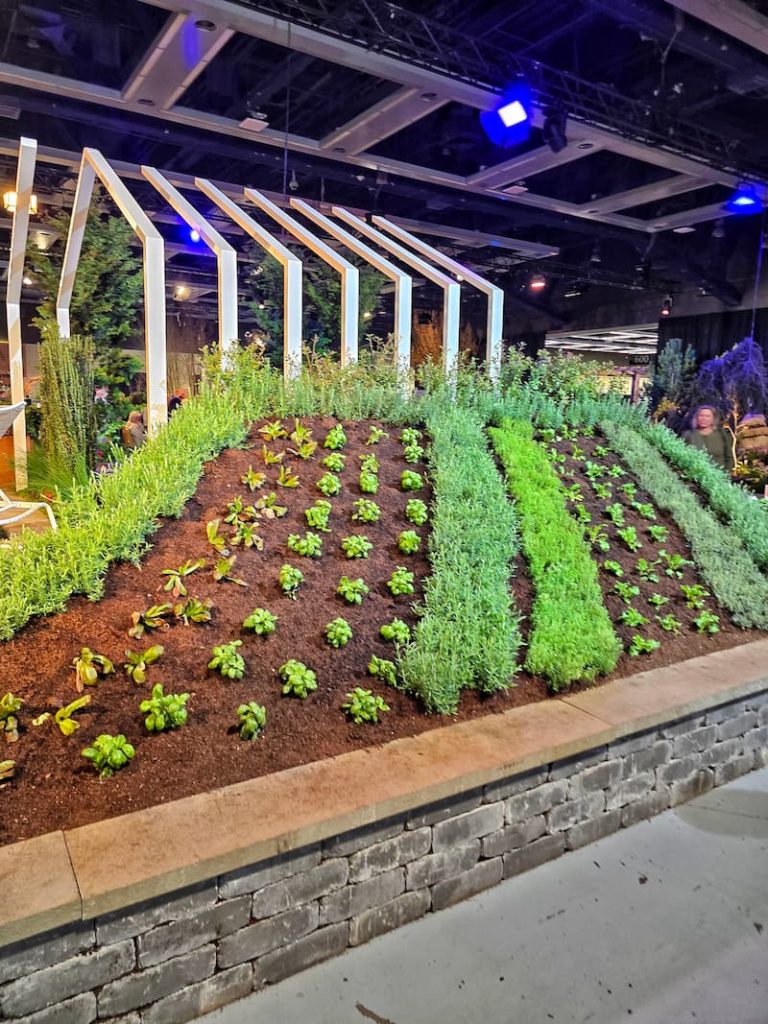
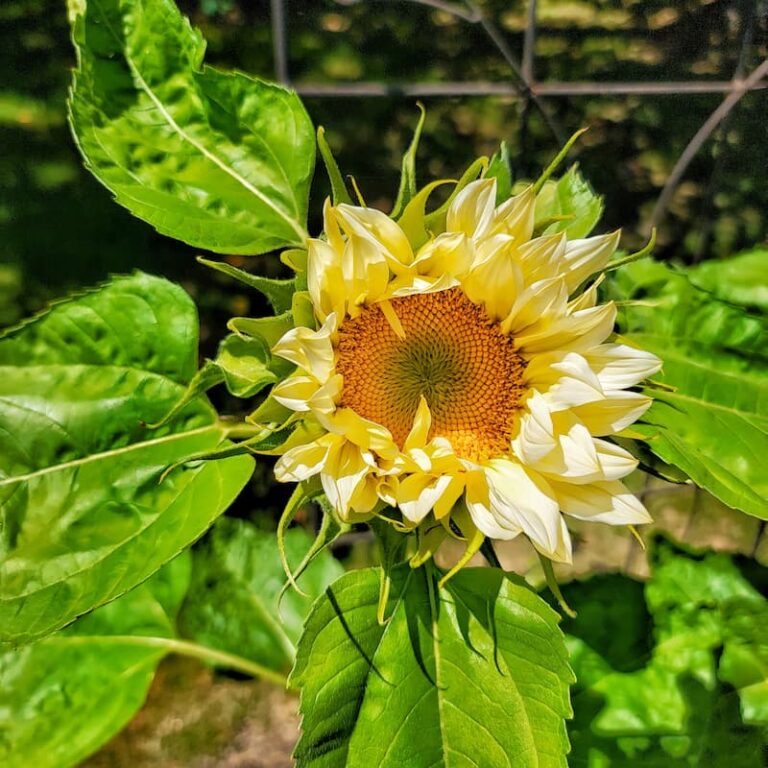
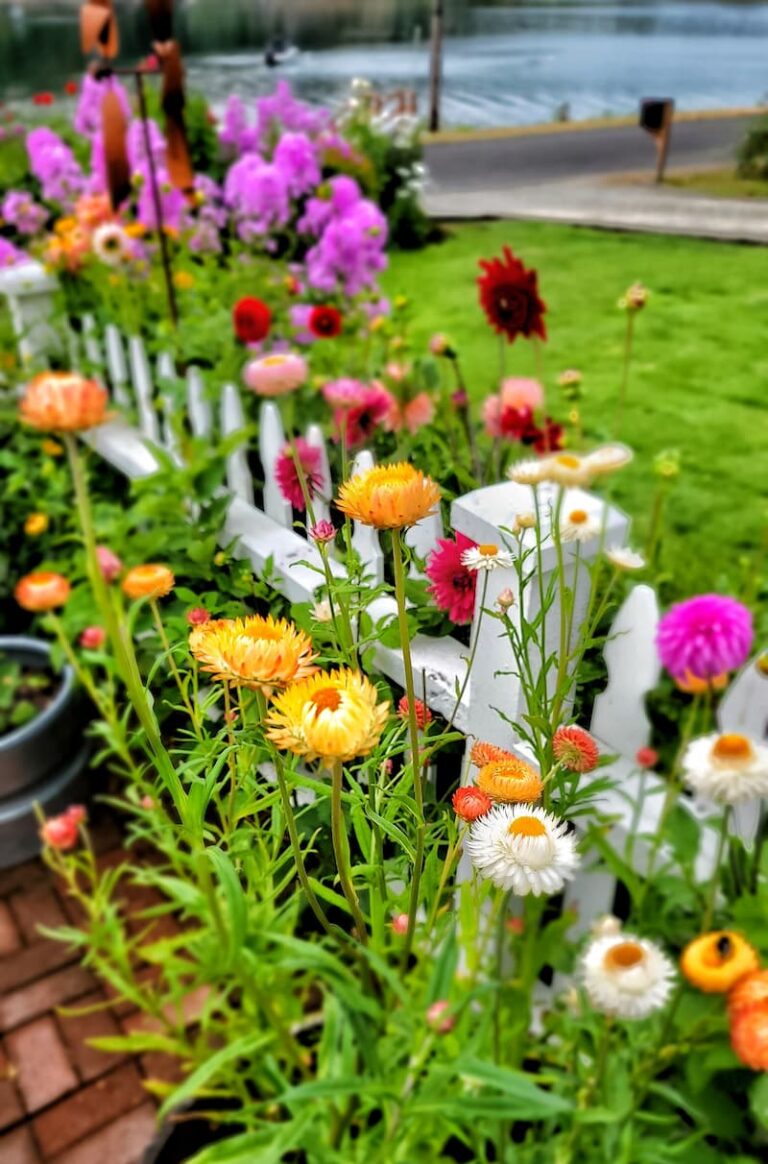


They really are the prettiest flowers! Yours always look so pretty by thee sea!
Thank you, Stacy! I don’t know what I’d do without them in my garden.
Kim you’ve grown some beatuiful dahlias thank you for all of your tips!
Thank you, Stacy! I have some new varieties that I’m excited to see in the garden this year.
You dahlias are so gorgeous! I love dahlias and am just starting to grow them. I didn’t dig mine up in the autumn so I’m thinking now (spring for me) is the time I should dig them up and separate them out. Also a new home would be good I think. Thanks so much for sharing all your tips.
Thank you for sharing your Dahlias, I can’t grow them in Florida! I’d love for you to share over at our weekly Wednesday Creative Crafts Linky Party https://creativelybeth.com/creative-crafts-linky-party-7-join-in-the-fun/
Have a great week!
Creatively, Beth
Thank you for the information Beth. I will definitely come visit or link party!
I have wanted to plant these for the last several years. Living in Michigan can be tricky caring for plants and this post was so helpful! Thanks for all the great info!
I am so glad this helped Kim! Dahlias can be very tricky and I know how lucky I am to have such an amazing climate for growing them here. I hope you decide to grow some next year!
Your dahlias look amazing! Great article!!!
Thank you Stacy! That means a lot coming from an incredible Master Gardener like you. So happy you are here.
Kim,
Absolutely beautiful flowers and what n informative post!! Thanks so much for taking the time to visit!
Hugs,
Deb
Oh thank you Deb. Dahlias are such a beautiful flower. I appreciate the compliment!